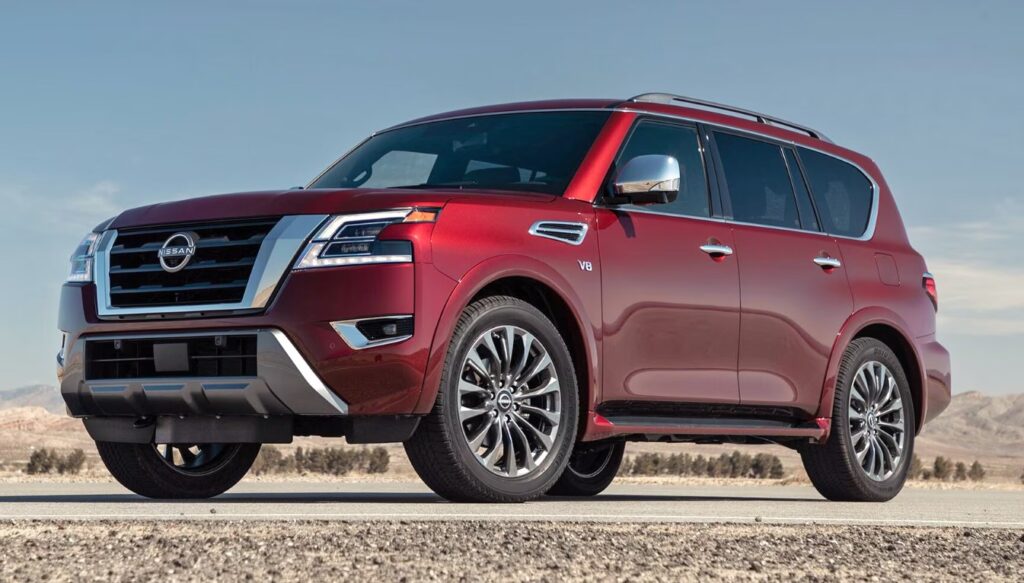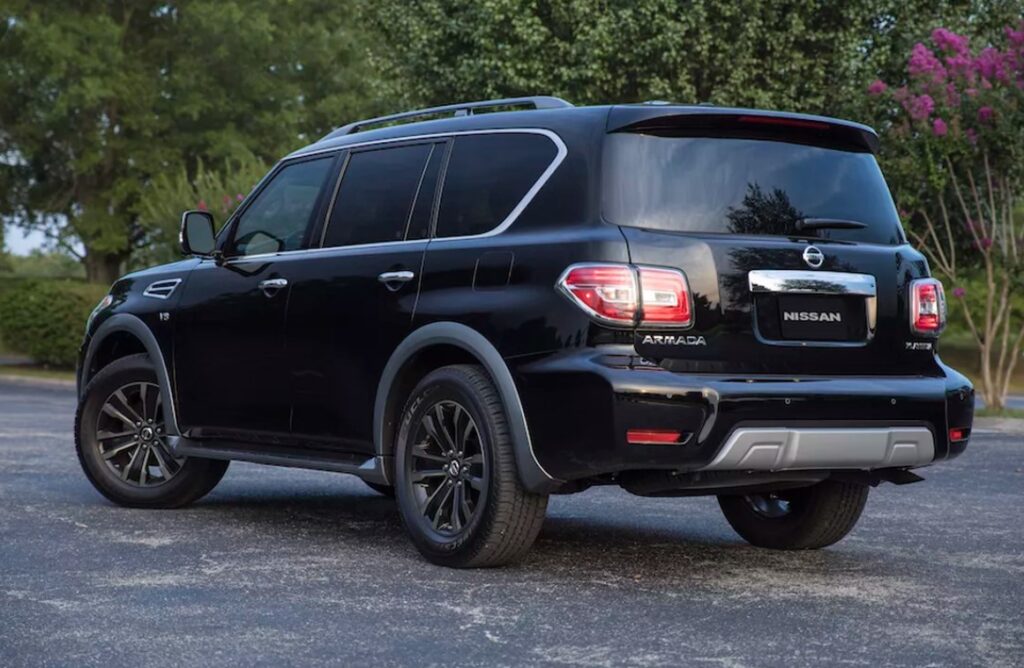Why Does My Nissan Armada Honk Three Times? Answered
Are you looking for Why Does My Nissan Armada Honk Three Times? When you step out of your Nissan Armada and hear it honk three times, it’s not just a random occurrence. This feature is actually a built-in safety measure designed to alert you. Let’s dive into the reasons behind this honking pattern and what it means for Armada owners.
Key Takeaways
- The triple honk is a Rear Door Alert (RDA) system feature.
- It’s designed to prevent drivers from forgetting children or items in the backseat.
- The feature can be turned off if preferred.
Why Does My Nissan Armada Honk Three Times?
Your Nissan Armada likely honks three times due to the Rear Door Alert (RDA) system, which is designed to remind you to check the rear seats for occupants or items after you park and lock the vehicle.
If a rear door was opened before starting your trip but not reopened after parking, the system assumes something may have been left in the back seat and issues the honks as a reminder.

Why Nissan Armada Beeping 3 Times?
The Nissan Armada may beep three times for several reasons, typically related to the vehicle’s various alert systems. Here are the main reasons you might hear this specific beeping pattern:

- Rear Door Alert (RDA): The most common reason for the three beeps is the Rear Door Alert system. It’s designed to remind you to check the rear seats for occupants or items after the vehicle is parked. If a rear door was opened and closed before a trip but not reopened after the trip, the system assumes something may have been left in the back seat and issues the beeps as a reminder.
- Lock Confirmation: Some vehicles issue a series of beeps as a confirmation that the car has been locked via the key fob. If the Armada beeps three times upon locking, it could be indicating that the car is now secure. However, if it beeps three times and does not lock, it could be a sign that a door is not fully closed, or there’s another issue preventing the vehicle from locking.
- Security Alert: The beeping might also be part of the vehicle’s anti-theft system. If the system detects a potential unauthorized entry or tampering, it may beep to alert you.
- Key Fob Battery Low: If the battery in the key fob is running low, the vehicle may beep multiple times to alert you to change the battery.
- System Malfunction: A malfunction in the vehicle’s electronic system, such as the keyless entry system or onboard computer, could cause the vehicle to beep. This would typically be accompanied by a warning light or message on the dashboard.
- Driver Attention Alert (DAA): Some Nissan vehicles are equipped with a Driver Attention Alert system that beeps to warn the driver of potential inattention or drowsiness. If the Armada is equipped with such a feature and it detects inattentive driving patterns, it may beep to alert the driver.
- Seatbelt Reminder: If the vehicle detects an occupied front seat without a buckled seatbelt, it may beep to remind the occupant to fasten their seatbelt.
- Open Trunk/Liftgate: If the trunk or liftgate is not fully closed, the vehicle may beep to notify you that it is still open.
- Parking Sensors: If the Armada is equipped with parking sensors and you’re in close proximity to an object while parking or pulling out, the vehicle may beep to warn you of the nearby obstacle.
Understanding the Nissan Armada’s Safety Features
The Nissan Armada comes equipped with a variety of safety features, one of which includes the RDA system. This system is particularly useful for drivers who have a habit of leaving items in the backseat. The three honks serve as a reminder to check the rear seats before walking away from the vehicle.

The Role of the Rear Door Alert System
The Rear Door Alert System is an innovative feature that Nissan has introduced to enhance the safety of its vehicles. If the system detects that a rear door was opened and closed before a trip but wasn’t reopened afterward, the car will honk three times to remind you to check the backseat.
Deactivating the Rear Door Alert System
For those who find this feature unnecessary or bothersome, deactivating the RDA system is a straightforward process. It can be turned off with a button located near the driver’s left knee, providing flexibility for the driver’s preferences.
Safety First: The Importance of the RDA System
While some may find the honking sound to be a nuisance, the importance of the RDA system cannot be overstated. It’s a critical feature that serves as a last line of defense against accidentally leaving children or pets in the vehicle, which can be dangerous, especially in extreme weather conditions.
Customizing Your Nissan Armada’s Alerts
Nissan understands that not all drivers have the same needs, which is why they’ve made the RDA system’s alerts customizable. Customizing your Nissan Armada’s alerts means you can have the safety features you need without any additional distractions.
The Technology Behind the Triple Honk
Delving deeper into the technology behind the triple honk, we find that it’s not just a simple sound mechanism but a part of a complex system designed to ensure the safety and convenience of the driver and passengers.
New Aspects For Nissan Armada’s Honking Feature

Enhancing Driver Awareness
The Nissan Armada’s honking mechanism is more than just a reminder; it’s a tool for enhancing driver awareness. This auditory cue is designed to become a part of the driver’s routine, ensuring that checking the backseat becomes a habit.
The honk is a subtle yet effective way to increase safety without being intrusive. Drivers can rest assured that their vehicle is looking out for them, even when they’re preoccupied with the day’s concerns.
Incorporating this feature, Nissan has tapped into the psychological aspect of sound alerts. The distinct pattern of three honks is not easily ignored and is different enough from other car alarm sounds to prompt immediate attention.
This design choice reflects a deep understanding of human behavior and how drivers interact with their vehicles.
Nissan’s Commitment to Child Safety
Nissan’s triple honk feature is part of a broader commitment to child safety. The automaker has taken a proactive stance in preventing heatstroke incidents, which can occur if children are accidentally left in vehicles.
By integrating this feature, Nissan is contributing to a culture of safety that extends beyond the driving experience to the well-being of passengers after the journey has ended.
The company’s dedication is also evident in their participation in awareness campaigns and collaborations with child safety organizations.
These efforts aim to educate the public on the dangers of leaving children unattended in cars and the importance of double-checking the backseat. Nissan’s approach goes beyond just manufacturing cars; it’s about nurturing a safe environment for the most vulnerable passengers.
Customization for Different Drivers
Recognizing that every driver has unique needs, Nissan has ensured that the Armada’s honking feature can be customized. This customization extends to the volume, pattern, and circumstances under which the honk is activated.
For instance, parents who regularly transport children might prefer a louder and more persistent honk, while those using the vehicle primarily for cargo might choose a softer tone or even disable the feature.
The customization process is user-friendly, allowing drivers to adjust settings through the vehicle’s infotainment system. This flexibility is a testament to Nissan’s understanding that a one-size-fits-all approach doesn’t apply to driver alerts. By offering these options, Nissan empowers drivers to tailor their vehicles to their lifestyles.
The Future of Vehicle Alert Systems
Looking ahead, the triple honk is just the beginning of vehicle alert systems. Nissan is at the forefront of integrating more advanced technologies, such as sensors that can detect the presence of passengers and items left behind.
Future iterations may include visual alerts on the driver’s smartphone or dashboard, as well as integration with home automation systems to alert drivers even when they’re away from the vehicle.
These advancements are part of a larger trend in the automotive industry towards connected cars that communicate with drivers, passengers, and even smart home devices.
Nissan’s investment in research and development in this area signals a future where cars are not just modes of transportation but active participants in ensuring the safety and convenience of their occupants.
What Is Nissan Rear Door Alert And How Does It Work?
Nissan’s Rear Door Alert (RDA) is an innovative safety feature designed to remind drivers to check the rear seat after parking their vehicle.
This system is particularly useful for ensuring that children or pets are not accidentally left inside the car, especially on hot or cold days where the risk of temperature-related harm is significant.

Here’s how the Rear Door Alert system works:
- Activation: The RDA system monitors the rear doors of the vehicle. It activates when a rear door is opened and closed before a trip starts, indicating that something or someone may have been placed in the back seat.
- Drive and Park: After the driver reaches their destination and turns off the car, the system performs a check.
- Notification: If the rear door was opened at the start of the trip but not reopened at the end, the system assumes that the driver may have forgotten something in the back seat. In response, the system issues a series of distinctive honks – this can be a sequence of three honks, for example – to alert the driver to check the rear seat.
- Adjustability: Drivers can adjust the RDA system’s settings through the vehicle’s infotainment system, including turning it off if they choose to.
The Rear Door Alert system is part of Nissan’s ongoing commitment to vehicle safety and innovation. It’s a simple yet effective tool that leverages auditory cues to promote driver awareness and prevent potential tragedies.
How Do You Turn Off The Rear Door Alert On A Nissan Armada?
Turning off the Rear Door Alert (RDA) on a Nissan Armada is a straightforward process. Here’s a detailed step-by-step guide:

- Start the Vehicle: Begin by starting your Nissan Armada to access the vehicle’s infotainment system. The vehicle should be parked safely with the engine running to ensure that all the settings can be accessed.
- Access the Vehicle Settings: Navigate to the settings menu on the infotainment display. This is typically done by pressing a ‘Settings’ button on the touchscreen or using the vehicle’s control knob to scroll to the ‘Settings’ option.
- Select the RDA Settings: Within the settings menu, look for an option related to vehicle alerts or convenience features. Select ‘Rear Door Alert’ or a similarly named option to access the RDA settings.
- Modify the RDA Options: Once in the RDA settings, you should see options to modify the alert. There will typically be an option to turn the RDA system off. Select this option to disable the alerts.
- Confirm the Changes: After selecting to turn off the RDA, you may be prompted to confirm your choice. Confirm that you want to disable the system. This might require pressing ‘Yes’ or ‘Confirm’ on a popup dialog box.
- Exit the Settings: Once you have confirmed your selection, you can exit out of the settings menu by pressing the ‘Back’ button or the home button to return to the main screen of the infotainment system.
- Test the Changes: To ensure that the RDA has been disabled, you can perform a simple test. Shut off the vehicle, open and close the rear door, and then lock your vehicle and walk away. If the RDA is successfully turned off, the vehicle should not honk.
Conclusion
The triple honk you hear when exiting your Nissan Armada is a thoughtful feature from Nissan, designed to keep your loved ones and valuables safe. It’s a part of the brand’s commitment to safety and innovation.
While it may take some getting used to, the Rear Door Alert system is a feature that showcases Nissan’s attention to detail in enhancing the driving experience.
As Nissan continues to innovate, we can expect to see more intelligent features that protect and assist drivers and passengers alike. The three-time honk is a hallmark of Nissan’s dedication to its custom
Top FAQ’s
How does the Nissan Armada’s honk feature enhance driver awareness?
The Nissan Armada’s honk feature serves as an auditory reminder for drivers to check their vehicle before locking it. This can prevent children from being accidentally left inside, which is a significant safety concern. The triple honk is distinct and prompts immediate attention, reinforcing the habit of checking the backseat.
Can the Nissan Armada’s honking feature be customized for different drivers?
Yes, the Nissan Armada allows customization of the honking feature. Drivers can adjust the volume, pattern, and activation circumstances through the vehicle’s infotainment system, tailoring it to their preferences and needs.
What does the future hold for vehicle alert systems like the Nissan Armada’s honk feature?
The future of vehicle alert systems is likely to include more advanced technologies, such as sensors and connectivity features that provide visual alerts and integrate with smartphones and home automation systems. Nissan is actively researching and developing these technologies to enhance vehicle safety and convenience.
Updating the navigation system usually involves downloading the latest map data onto a USB drive or SD card and then loading it into the vehicle’s system. Nissan provides detailed instructions on their website or through dealerships.

Welcome to the exhilarating world of Matt Rex, a professional car racer turned renowned vehicle enthusiast. Immerse yourself in his captivating blog as he shares heart-pounding adventures, expert reviews, and valuable insights on cars, trucks, jets, and more. Fuel your passion for speed and discover the beauty of vehicles through Matt’s engaging stories and meticulous expertise. Join the ever-growing community of enthusiasts who find inspiration and expert advice in Matt Rex’s blog—a digital hub where the thrill of speed meets the pursuit of knowledge.


![Tesla Autosteer Speed Restricted Or Exceeded [Reasons]](https://www.turbochaos.com/wp-content/uploads/2023/08/Tesla-Autosteer-Speed-Restricted-Or-Exceeded.jpg)

![Best Oil For Subaru Ascent [Best Oil Recommendations]](https://www.turbochaos.com/wp-content/uploads/2023/07/Best-Oil-For-Subaru-Ascent-768x512.jpg)


